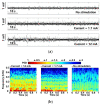A mm-Sized Free-Floating Wireless Implantable Opto-Electro Stimulation Device
- PMID: 32630557
- PMCID: PMC7345121
- DOI: 10.3390/mi11060621
A mm-Sized Free-Floating Wireless Implantable Opto-Electro Stimulation Device
Abstract
Towards a distributed neural interface, consisting of multiple miniaturized implants, for interfacing with large-scale neuronal ensembles over large brain areas, this paper presents a mm-sized free-floating wirelessly-powered implantable opto-electro stimulation (FF-WIOS2) device equipped with 16-ch optical and 4-ch electrical stimulation for reconfigurable neuromodulation. The FF-WIOS2 is wirelessly powered and controlled through a 3-coil inductive link at 60 MHz. The FF-WIOS2 receives stimulation parameters via on-off keying (OOK) while sending its rectified voltage information to an external headstage for closed-loop power control (CLPC) via load-shift-keying (LSK). The FF-WIOS2 system-on-chip (SoC), fabricated in a 0.35-µm standard CMOS process, employs switched-capacitor-based stimulation (SCS) architecture to provide large instantaneous current needed for surpassing the optical stimulation threshold. The SCS charger charges an off-chip capacitor up to 5 V at 37% efficiency. At the onset of stimulation, the capacitor delivers charge with peak current in 1.7-12 mA range to a micro-LED (µLED) array for optical stimulation or 100-700 μA range to a micro-electrode array (MEA) for biphasic electrical stimulation. Active and passive charge balancing circuits are activated in electrical stimulation mode to ensure stimulation safety. In vivo experiments conducted on three anesthetized rats verified the efficacy of the two stimulation mechanisms. The proposed FF-WIOS2 is potentially a reconfigurable tool for performing untethered neuromodulation.
Keywords: charge balancing; free-floating implants; inductive link; switched-capacitor-based optical/electrical stimulation.
Conflict of interest statement
The authors declare no conflict of interest.
Figures















Similar articles
-
A mm-Sized Free-Floating Wirelessly Powered Implantable Optical Stimulation Device.IEEE Trans Biomed Circuits Syst. 2019 Aug;13(4):608-618. doi: 10.1109/TBCAS.2019.2918761. Epub 2019 May 23. IEEE Trans Biomed Circuits Syst. 2019. PMID: 31135371 Free PMC article.
-
A Trimodal Wireless Implantable Neural Interface System-on-Chip.IEEE Trans Biomed Circuits Syst. 2020 Dec;14(6):1207-1217. doi: 10.1109/TBCAS.2020.3037452. Epub 2020 Dec 31. IEEE Trans Biomed Circuits Syst. 2020. PMID: 33180731 Free PMC article.
-
A wireless implantable switched-capacitor based optogenetic stimulating system.Annu Int Conf IEEE Eng Med Biol Soc. 2014;2014:878-81. doi: 10.1109/EMBC.2014.6943731. Annu Int Conf IEEE Eng Med Biol Soc. 2014. PMID: 25570099 Free PMC article.
-
A Bidirectional Neuromodulation Technology for Nerve Recording and Stimulation.Micromachines (Basel). 2018 Oct 23;9(11):538. doi: 10.3390/mi9110538. Micromachines (Basel). 2018. PMID: 30715037 Free PMC article. Review.
-
Automatic frequency controller for power amplifiers used in bio-implanted applications: issues and challenges.Sensors (Basel). 2014 Dec 11;14(12):23843-70. doi: 10.3390/s141223843. Sensors (Basel). 2014. PMID: 25615728 Free PMC article. Review.
Cited by
-
Wireless Photometry Prototype for Tri-Color Excitation and Multi-Region Recording.Micromachines (Basel). 2022 Apr 30;13(5):727. doi: 10.3390/mi13050727. Micromachines (Basel). 2022. PMID: 35630195 Free PMC article.
-
Fully implanted battery-free high power platform for chronic spinal and muscular functional electrical stimulation.Nat Commun. 2023 Nov 30;14(1):7887. doi: 10.1038/s41467-023-43669-2. Nat Commun. 2023. PMID: 38036552 Free PMC article.
-
Micromachines 2022 Best Paper Awards.Micromachines (Basel). 2022 May 30;13(6):858. doi: 10.3390/mi13060858. Micromachines (Basel). 2022. PMID: 35744472 Free PMC article.
References
-
- World Health Organization . Neurological Disorders: Public Health Challenges. World Health Organization; Geneva, Switzerland: 2006.
Grants and funding
LinkOut - more resources
Full Text Sources

